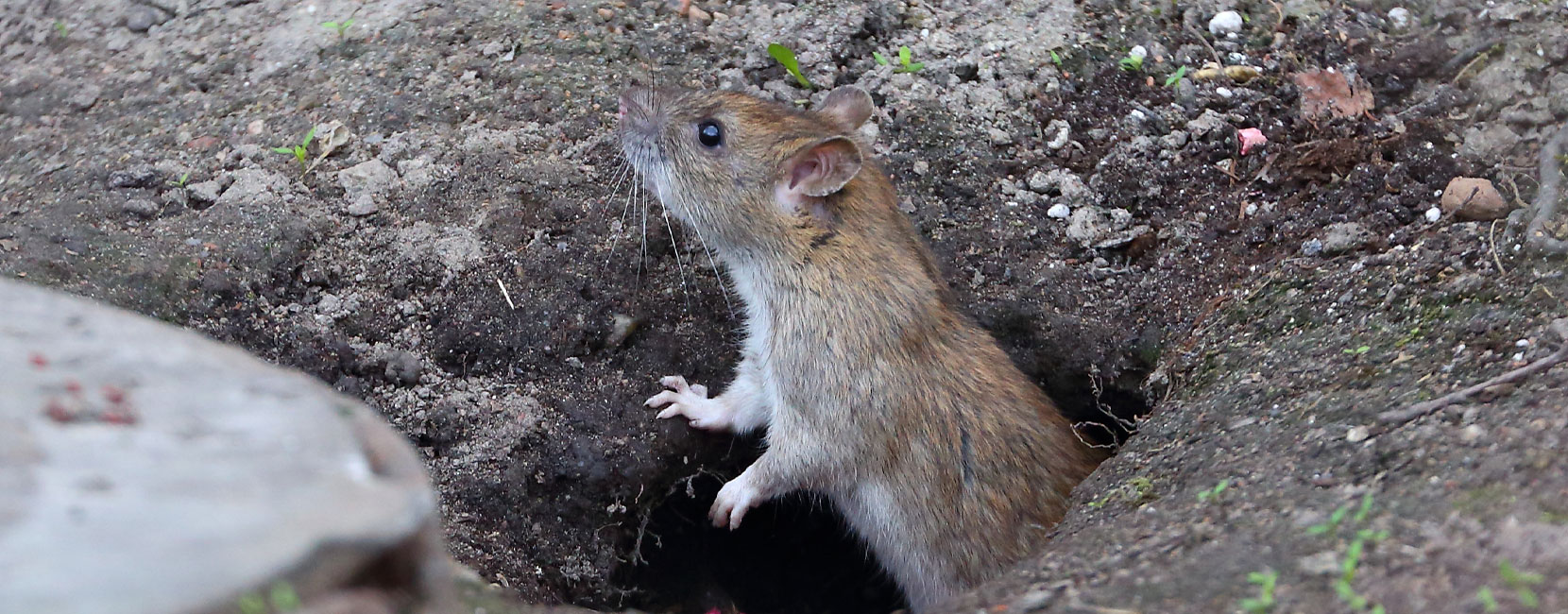
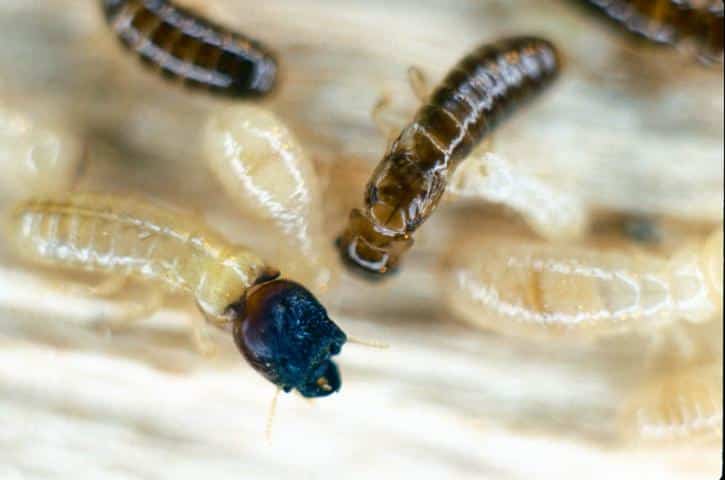
Between subterranean termites, drywood termites, and dampwood termites, it is estimated that Americans spend upwards of $5 Billion dollars per year, preventing, treating, and repairing damage caused by termites. The initial instinct of many people when faced with unfamiliar flying insect, is to assume the worst and work yourself into believing your house is about to fall down. Proper identification of the insect is paramount so that you can assess the risk to your home and get rid of the pest safely and efficiently.
As the risk of damage and treatments are different between subterranean and drywood termites, to avoid confusion, this article will focus on how to get rid of drywood termites. Drywood termites are important pests of structures throughout the country. The more destructive drywood termite species are restricted to certain warmer southern states and humid coastal areas.
Drywood termites feed on dry, sound (nondecayed) wood and are more commonly reported from older structures. Drywood termites do not live in the ground nor maintain contact with the soil, and they do not build mud tubes. Drywood termites do not need an additional water source, they obtain all the moisture they need from the wood that they consume. They can infest wood flooring, framing members, windowsills, doors, fascia boards, and furniture. They are also known to infest attics where the external temperature of the wooden members can exceed 110 degrees F.
The good news is you usually do not have to rush to treat drywood termites. Drywood termite colonies are rather small (a few dozen to a few thousand individuals), and colonies develop relatively slowly. They cause damage to your structure much slower than other termites. That is not to suggest they should be ignored indefinitely, but to remedy most drywood termite situations, you have time to properly research your options. Do not feel pressured to make a quick and rash decision.
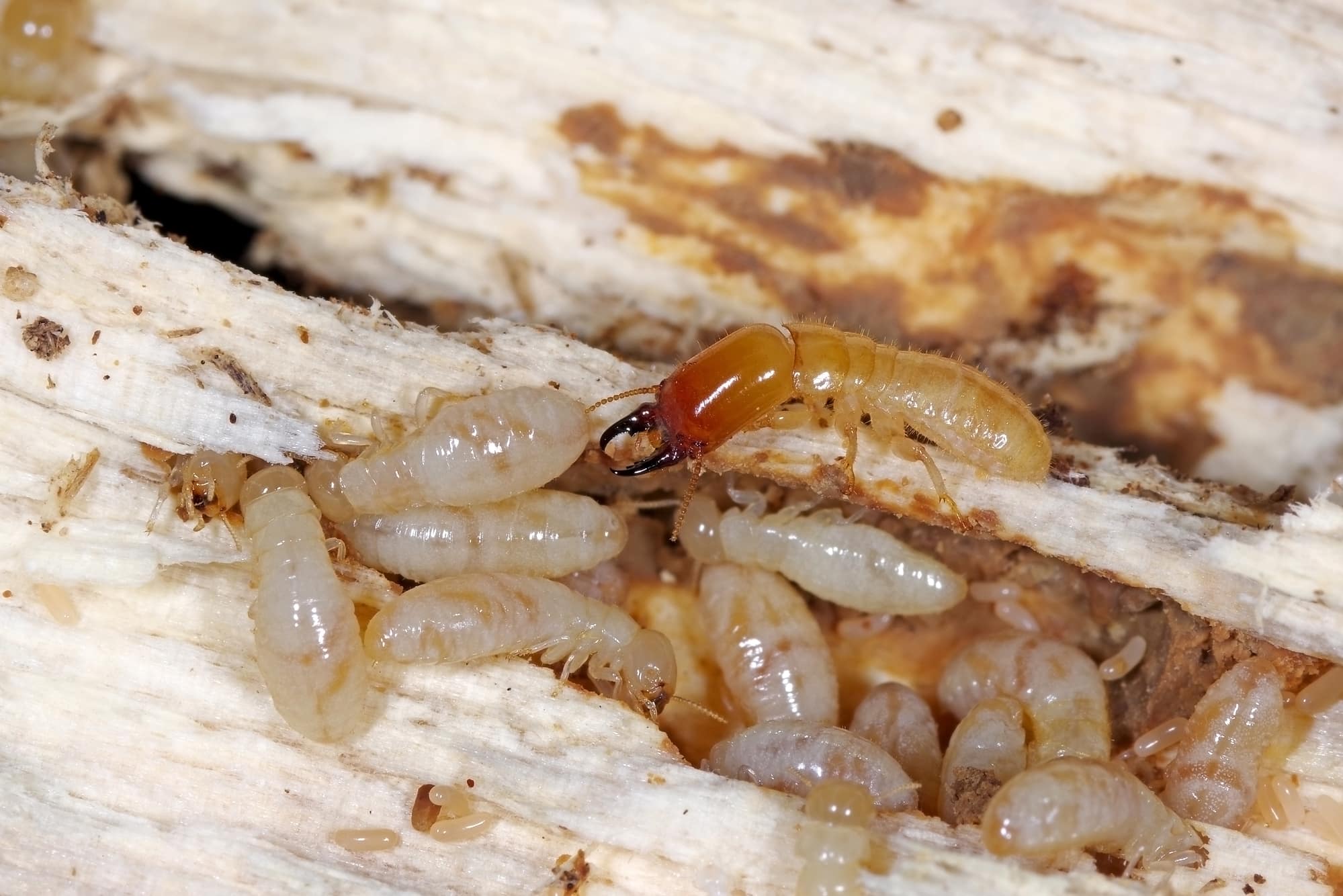
Drywood Termite Identification
The first sign of termite infestation for many people is an invasion of thousands of flying insects. This may happen inside your home or outside your home. However, before you jump to conclusions ensure that these insects are termites and not winged ants. Ant and termite colonies both send out reproductives, or swarmers, in an effort to create new colonies. By carefully examining one of these thousands of insects found on your porch or on your windowsill, you can quickly determine if it is a termite or an ant.
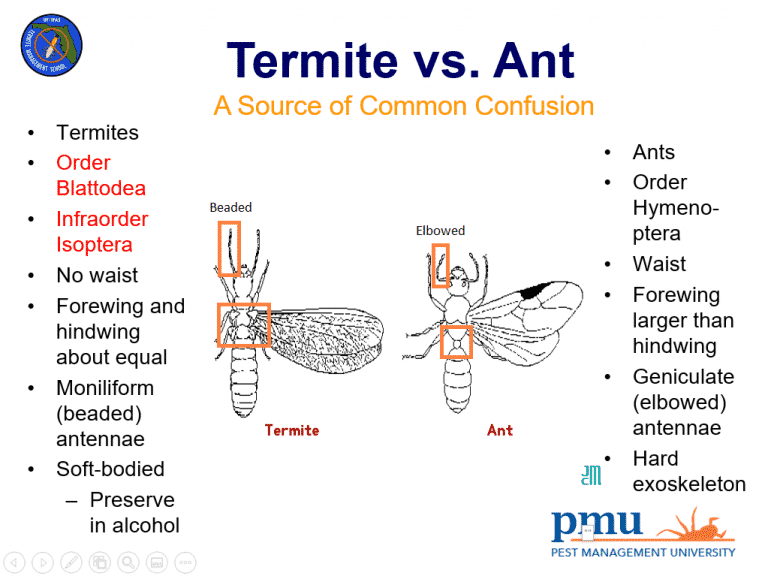
Below are the differences between ant and termite waists, wings, and antennae.
- Waist
- Ant – skinny waist (a narrow area between the thorax and first abdominal segment).
- Termite – no skinny waist, thorax and abdomen are broadly connected.
- Wings
- Ant – Front pair of wings is larger than the hind pair; few veins and usually clear in color.
- Termite – The four wings are approximately the same size and shape; many veins and may be milky in color.
- Antennae
- Ant – Antennae are elbowed.
- Termite – Antennae are straight.
From this cursory observation, you should be able to determine if you are dealing with ants or termites, and rest easier if you have ants swarming in or near your home. If you have termites on your hands, you then must figure out if they are drywood termites, or subterranean termites. While both of these termites eat wood and cause damage to our homes and other structures, the risks of damage and their treatments are much different. To make a more detailed identification, you may need the help of an expert. Collect any wings and bodies that you may find and seal them in rubbing alcohol. This prevents the insect from drying out and being damaged. Your local extension office or a Pest Management Professional can help you to identify whether you are dealing with subterranean or drywood termites.
Drywood Termite Species
There are three species of drywood termite (Order Isoptera, Family Kalotermitidae) that are of concern to homeowners. Drywood termites are most often found in the warm climates of southern California, Arizona, New Mexico, Arizona, Texas, Louisiana, Mississippi, Alabama, Georgia, and Florida. Under the right conditions, they can survive in cooler climates, although this is rare.
Drywood termites can be identified either by the insects themselves or by their unique signs. It is difficult to distinguish drywood termites from other termites based on samples of immatures alone. Effort should be made to collect either soldiers or winged forms to confirm a drywood termite problem. The shape and form of the mandibles (jaws) of the soldiers can be used to identify the species.
Southern Drywood Termite
Incisitermes snyderi
The Southern drywood termite lives in colonies that are generally larger than those of the West Indian drywood termite and cause more serious structural damage. They are found in both natural and human-made environments. Development of the colony is slow, but structural damage can be extensive if multiple colonies are present in the same structure. The Southern drywood termite usually swarms at night and flies towards the light between May through November.
Western drywood termite
Incisitermes minor
The Western drywood termite is the predominant drywood termite species located in the western United States. The Western drywood termite will swarm during the day between the end of August and November. The Western drywood termite soldiers are about 5/16” with dark yellow-brown heads and strong jaw.
West Indian drywood termite
Cryptotermes brevis
The West Indian drywood termite soldier has a distinctive square-shaped head, which resembles a burnt match. It uses this distinctive head to block the tunnels to protect the colony from intruders, especially ants. The West Indian drywood termite is concentrated around the United States Gulf Coast and Florida. It is unusual in that it is almost never found in natural environments, only in the wood of human-made structures. West Indian drywood termites are often found in picture frames, furniture, and other structural woodwork. They usually swarm between April to early June and but may swarm any time of year.
Drywood Termite Pellets
Once drywood termites infest a piece of wood, they remain inside. They obtain all the nutrition and moisture they need to survive from that piece of wood and have no need to go anywhere else. An often-overlooked sign of active drywood termites in your home, is the presence of their fecal matter or frass.
As the termites consume the wood in your home, they clean their gallery by pushing the fecal out of small holes called kick out holes. If the kick out hole is a few inches from a countertop or window sill, these fecal pellet will drop down and accumulate in piles underneath the area of infestation. If the kick out hole is higher up, the frass will bounce around and lay in a less organized pile. In this situation, the frass is often dismissed as dirt, or some other debris. Whether the frass be on your windowsill, on the living room floor, or near the door frame, it is easy to assume these droppings are dirt and simply wipe them up. However, in time, they will reappear.
Drywood termite pellets look like coffee grounds or a pile of course ground pepper. Individual drywood termite pellets are quite small, about 1 mm in length, and if you examine them closely, you will find they have 6 sides. The color can vary. Termite frass is not dangerous or harmful, like the droppings of other species, but it is an indicator of active termites and should not be ignored.




Social Classes of Drywood Termites
Drywood termites are eusocial creatures. They live together in colonies and cooperatively care for their young. The responsibilities of the colony are divided between different castes of termites, each with distinctive characteristics. The termites capable of reproduction are the king, queen, and alates. The colony also requires workers and soldiers. As drywood termites proceed through their life cycle, they molt, and ultimately become whatever type of termite the colony needs to thrive.
- Workers are responsible for creating tunnels and chambers, as well as feeding and grooming the other termites in the colony.
- Soldiers, with their enlarged heads and mandibles, defend the colony from invaders such as ants.
- Alates, or swarmers, are born with wings and are capable of reproduction. They will ultimately fly from the colony in an attempt to start their own colony.
Definitively, no one knows how or why a particular termite develops into a soldier, worker, or alate (reproductive). Studies suggest that the needs of the colony plays a part in the selection. Drywood termites are unique in that, should there become a shortage of a particular caste of termite, they can change. If necessary for the colony to survive, a worker can become an alate.
Drywood colonies grow slowly. They generally do not produce swarmers for about 5 years. This slow growth and maturation makes their presence less urgent than some other species of termites. However, they do not go away on their own and Drywood termites should not be ignored.
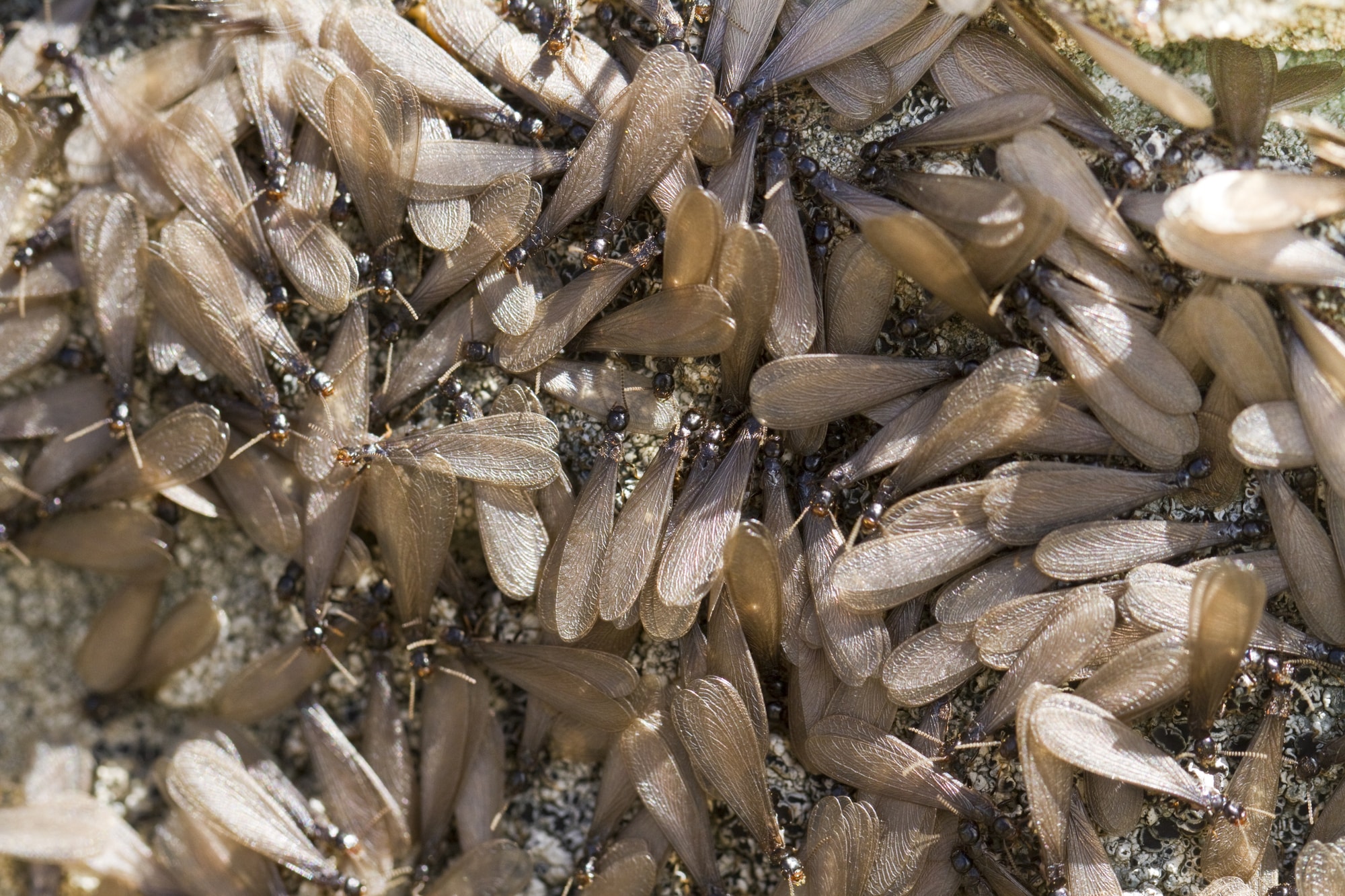
Winged Drywood Termites and the Life Cycle
The termite life cycle begins with the mating flight. After about 5 years, a mature drywood termite colony sends alates into the world. These winged termites are poor fliers, rather they float along the wind. Once they land, their wings fall off quickly, and they look for a suitable place to nest. Swarmers usually enter wood through cracks, overlapping or adjoining pieces, or exposed end grain. A very small nest is developed after the pair has mated.
Most termite swarmers are not successful in creating a new colony. They are often eaten by birds, ants, or reptiles, and succumb to injury or dehydration. The termites that do survive to mate and create a nest, become the king and queen of the new colony. The male remains with the female as periodic mating is necessary to continue to grow the colony. The king and queen are now responsible for the growth of this colony.
Initially, the drywood termite queen lays only a few eggs. In the early stages of the colony, the king and queen take care of the immature termites. As the colony becomes more established and has a greater depth of workers and soldiers, the queen lays more eggs.
Once the eggs hatch, termite larvae, or nymphs emerge. The nymphs are young immature termites. They go through several molts, and eventually take on the form and function of their caste. Some nymphs become soldiers (only about 1-2%), while others remain workers, and others become alates. It is rare for a homeowner to see the chambers in which the nymphs are hidden. Most of our visual experience is with termite swarmers.
Drywood Termite Damage
Drywood termite damage is distinct from other termite damage. Galleries are smooth sided and free of the mud spots typical of subterranean termites. Drywood termite galleries cut across both the light (spring) and dark (summer growth) wood rings, compared to subterranean termites, which feed primarily in the light growth rings and the galleries go along the grain. An experienced Pest Management Professional can determine drywood vs subterranean termite damage by inspecting the damaged wood.

Because drywood termite colonies grow slowly, the rate at which they consume and destroy wood is less alarming. However, because of the way they propagate and spread, it is not uncommon for multiple colonies to be inhabiting your home at once. If left untreated, drywood termites can cause extensive structural damage to your home or business.
Inspecting for Drywood Termites

Drywood termites are hidden, living within the wood, making them hard to find. These insects are usually detected when they swarm or kick out pellets, or when structures are repaired. A home remodeling project takes a detour and time delay when termites are located within the walls.
Visual inspections should be made in accessible areas. Sometimes walls may need to be removed to allow inspections behind them. When inspecting for drywood termites, look for:
- Swarming individuals (alates) – look for shed wings or dead bodies. They are attracted to light so windowsills are a good place to start looking.
- Damage – tapping wood with the handle of a screwdriver or probing with a sharp tool is helpful for detecting termite damage that is not obvious on the surface of damaged wood. A sign of advanced infestation is wood surface blistering or warping, where termites have tunneled just under the surface of the wood.
- Pellets or Termite frass:
- Pellets are ejected by termites through pencil-tip-sized kick-out holes (1-2 mm diameter) in infested material.
- Pellets may be multicolored and ranges from light brown to almost black.
- Pellets are gritty when rolled between the fingers, and when examined under magnification, will have six distinct sides.
- Wood near pellet piles should be examined for the kick hole, indicating the exact location of infested wood.
- The presence of these pellets does not necessarily mean that the structure is infested with active drywood termites. Pellets from a previously treated infestation may fall from wood following vibrations of the structure.
Active infestations would be indicated if either live drywood termites are found or more pellets appear a few days after pellets have been removed from a location.
Scent detecting dogs, acoustic devices, microwave motion detectors, and odor detectors may be used to detect drywood termites. A properly trained termite detecting dog and handler can efficiently inspect large areas in a reasonable amount of time. Acoustic devices amplify the sounds of the termites behind the walls.
Multiple drywood termite wings inside a building or evidence of drywood termite pellets warrants further inspection and possible treatment or removal of infested wood. Pellets in multiple locations may indicate need for building fumigation.
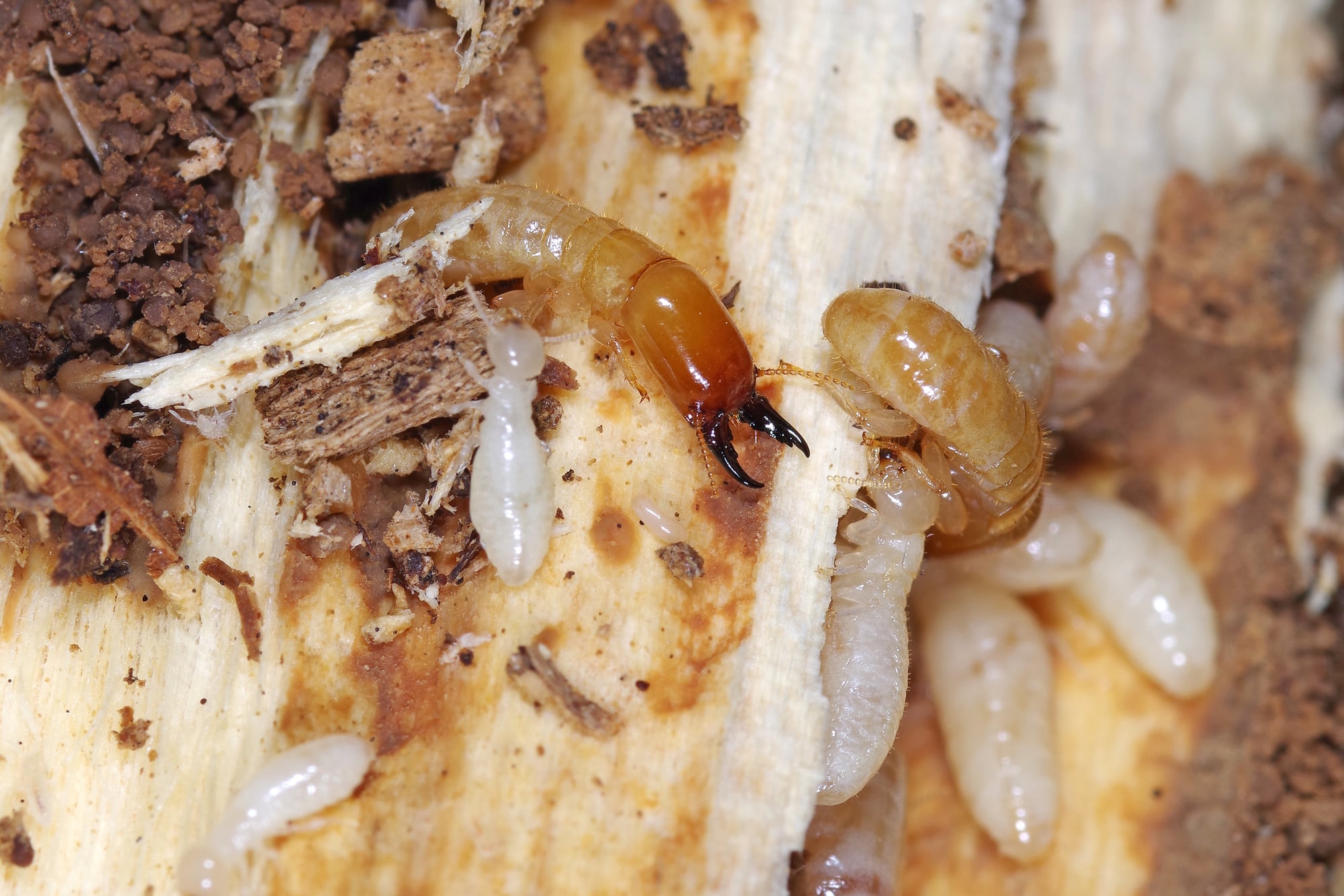
Can I do anything to Prevent Drywood Termites?
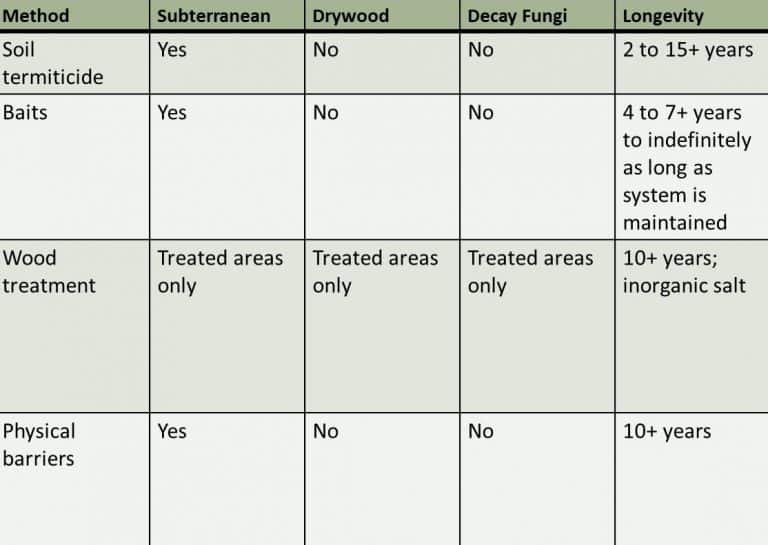
In some areas of the country, south Florida for example, it is often said, it is not if your home will get termites, but when. Termites can establish themselves in your home via a swarm, or you can introduce a termite colony on a piece of furniture. In termite rich environments, there is no way to guarantee against termites, but there are a few ways to minimize your exposure.
- A good coat of paint on exposed wood will provide some protection against termite entry. Before painting, all cracks and crevices should be filled with putty or plastic wood.
- Pressure-treated wood is resistant to termite attack.
- Consider treating exposed wood with a borate treatment. When a boric acid product is applied to wood, and termites attempt to consume the wood, the boric acid inhibits their digestive system from working properly and they starve to death.
- Certain woods are naturally resistant to termites, including redwood heartwood, bald cypress, mahogany, and Spanish cedar; however, these woods can be more expensive and will become susceptible after several years when subjected to aging and weathering.
- Construction should be designed to eliminate moisture and water leaks.
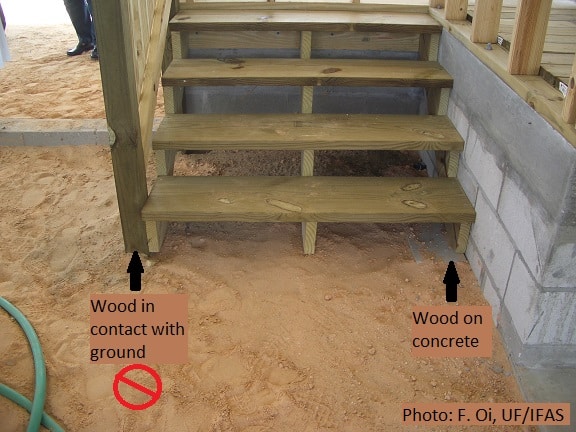



What you can do to prevent termites, continued:
- Landscape plants should be placed at least 2 feet away from exterior walls (Figure 14).
- Account for future growth.
- Improper plant placement will create conducive conditions that may void termite warranties (Figure 15a, b).
- Avoid using wooden landscape timbers for edging.



- Keep soffits in good repair and screen vents to help prevent termite swarmers and other pests from entering attics.
- Trim tree and shrub branches away from walls and roofs (Figure 16).
- Branches that touch the roof of a structure can allow subterranean termites to use it as a bridge and access structures (Figure 17).


Natural Control Options for Drywood Termites
Sometimes the least sophisticated option is still the best. If you determine that the drywood termite infestation is isolated, wood removal and replacement may be the best option. This may be a simple frame around a window, or that old broken dresser in the spare bedroom. Removing the affected wood, eliminates the problem without chemicals.
There are other non-chemical forms of termite control that can be considered. You should be aware that the usefulness of nonchemical, spot treatments for drywood termites such as microwaves, electricity, and cold are limited by the operator’s ability to identify and reach all infested wood. Often, there is more than one drywood termite colony in an old house. Non-chemical treatments for drywood termites are not common, but can be a useful tool in sensitive environments such as hospitals, nursing homes, and schools. These non-chemical options are best applied to localized infestations rather than widespread severe infestations.
Heat Treatments for Drywood Termites
Drywood termites regularly infest wood in attics which can become excruciatingly hot in the summertime. To kill termites using heat, the interior of the wood, where the termites are living, must be heated to at least 120℉ for a period of time. Higher temperatures kill the Drywood termites faster. This temperature is maintained until the termites are dead.
Specialized heaters, fans, and temperature probes are brought in and placed in the area to be treated. You can choose to have your entire home heat treated, or just the area of known drywood termite activity. The skill of the technician is directly related to the success of this type of treatment. If the interior of the wood does not get hot enough, termites will not die. In addition, if you choose heat as a spot treatment, other drywood colonies, that were unknown to you, will continue to flourish. Depending on the areas being treated, heat may damage some sensitive electronic items within your home.
Freezing Treatments for Drywood Termites
Cold, especially in the form of liquid nitrogen, can be injected directly into termite galleries in order to freeze the insects. Temperatures around 20°F must be reached so that termites can be killed with very short exposure, and precautions must be taken to prevent operator asphyxiation and burns. In addition, care must be used when using liquid nitrogen around pipes to prevent them from freezing and bursting.
Electrical and Microwave Treatments for Drywood Termites
Due to the cryptic hidden nature of drywood termites, scientist are always looking for new and innovative technologies for their detection and treatment. Devices that utilize microwaves are used to detect termite activity in areas that can not be seen with the naked eye. Microwaves are also used to treat termite galleries within wood. Rather than warming up a plate of leftovers, Pest Management Professionals with specialized equipment, can aim microwaves at a specific piece of wood that is known to contain termites. Using these waves, the termites in the wood are “cooked” so that it kills the termites. Again, a microwave treatment is only as effective as the skill of the technician and identification of the termite galleries.
Spot Treatments for Drywood Termites
For small, localized infestations, such as when a door frame, window frame, furniture, or limited portions of wood are infested a spot treatment may be used. Spot treatments are low cost and convenient, but they cannot ensure complete eradication of the termites within the structure. During a spot treatment, termiticide is injected directly into the termite galleries. This injection directly exposes some of the individuals in the colony to the pesticide. Then because of their grooming and social behaviors, the insecticide is transferred to all the other termites in the gallery.
These spot treatments are effective at killing the drywood termite colonies that you know about, but they have no effect on an unknown or inaccessible colony in the structure. In addition, if the colony is in fact larger than the applicator believes, and not all of the termites are exposed to the pesticide, the treatment will fail. Termites who survive a spot treatment can live to reestablish an infestation. Spot treatments are often used to “buy time” when a fumigation is impracticable.
Dusts, liquids, sprays, or foams can be used in a drywood termite spot treatment. The product chosen must be non-repellent so that you ensure the termite contacts the product. If repellent formulations are used, termites will simply avoid contact with the product and the treatment will be ineffective. In addition, ensure the product you have chosen is labeled for the application site. If you are treating termites inside of a structure, make sure the product is labeled for indoor use on drywood termites.
Spray applications can also be made to cracks and crevices such as the spaces between wooden pieces or between different building materials, such as wood and concrete, where there is evidence of an infestation.
Fumigation for Drywood Termites
If the infestation is too extensive and advanced for spot treatment, it may be necessary to tent and fumigate the entire building. Although this method can be expensive and inconvenient over several days, it is frequently the only effective option for serious infestations.
Fumigation, sometimes referred to as “tenting” or a “termite tent” involves placing a large, heavy duty tent over the entire structure. The gas Sulfuryl fluoride, commonly referred to as Vikane®, is blown into the building and the held at a specific concentration for a period of time. Sulfuryl fluoride is colorless and odorless, and extremely toxic. This gas is able to penetrate all cracks and crevices including the wood where the termite colonies live. When the fumigation process is complete and your home has been properly ventilated, everything that was under the tarp will have died, including termites, bed bugs, roaches, and rodents. After the structure is aired out, there is no residual from the fumigant. This means that there is no danger for people or pets, but there is also nothing left behind to prevent termites from reinfesting the same home again.

Fumigation is a vital tool for controlling drywood termites, but it must be performed by trained and licensed professionals. This is not a Do-It-Yourself job. Reputable fumigation companies, holding the appropriate licenses, insurance, and instruments, can and do safely perform fumigations. When proper aeration steps and safety protocols are vigorously followed, there is minimal risk to homeowners. Because drywood termite damage occurs slowly, there should be no need to rush into a fumigation, which is best scheduled for holidays or during summer vacation. However, this process provides no residual protection. Twenty-four hours after fumigation is completed, fumigants will no longer provide protection from drywood termites.
A properly performed fumigation is the only way to ensure that every drywood termite in the house has been eliminated. Fumigation kills termites behind walls, in the rafters of the attic, and in wood floors that you didn’t even know about.
Preparing for Fumigation
Many people put off fumigating their home for years. However, there comes a time for many, that another spot treatment will simply not have much effect. The cost of fumigations are very much dependent upon your location. Drywood termites are common in South Florida and Southern California, therefore the prices for this service are competitive. In areas with fewer drywood termites and few companies that are able to perform this service, the price for a fumigation can be quite high. In addition to the cost, the time and attention required of you the homeowner to prepare for the fumigation can be burdensome. Most foods and medications will need to be removed or bagged in special bags. The company performing the fumigation will give you a detailed check list of the preparations you must do before the fumigation. You and your family and pets will have no access to your home for approximately 72 hours. All cabinets, doors, and attic accesses will need to be opened. In addition, the fumigator will need access to any space large enough to possibly hold a person. This is to perform a safety check before the fumigation and to verify all fumigant is gone after the fumigation. Locked rooms, armoires, and safes can cause a postponement of the fumigation. Be sure to make other arrangements for the storage of valuables. Making other sleeping and eating arrangements can be extremely inconvenient for many people and can significantly add to the cost of the fumigation. When possible, many people choose to fumigate when they are planning on being away on vacation.
Vault Fumigation
Drywood termites often enter our homes on antique furniture or fixtures. If it can be determined that the termite infestation is localized, but spot treatments have not been successful a vault fumigation may be a reasonable next step. When you participate in a vault fumigation, your piano or armoire will be placed inside a vault with other people’s termite infested belongings. The vault will be fumigated, ensuring all the termites in the treated property are killed. While vault fumigation is only appropriate in certain circumstances, this process eliminates drywood termites from portable objects without the inconvenience of a whole house fumigation. Vault fumigation is also much cheaper than whole-house fumigation. However, you may possibly need to hire movers to move the items to the vault located at a pest control business.
How to Submit a Termite Sample for Identification
If you plan to submit termites for identification, please place as many termites as you can collect in a small, tightly sealed container of rubbing or 70% isopropyl alcohol (Figures 7a, b, c). The winged swarmers and soldiers are best for identification. Workers are the most numerous in the colony, but the most difficult to use in identification.



Do NOT mail termites in a plastic bag placed in an envelope because important characteristics are crushed during delivery (Figure 8). If you plan to mail the sample, place the container in a box.
Please include the following information: Name, how best to contact you (e.g., email, phone number) date, location (address) collected, where collected (i.e., inside or outside home, door or window framing, wooden studs, etc.). Some insect identification laboratories have fillable forms with questions that can aid in identification. See example: http://edis.ifas.ufl.edu/pdffiles/SR/SR02200.pdf
Submitting pictures of termite damage can be helpful, but generally insect identification requires a sample. The vast majority of photographs submitted do not include the characteristics needed for identification and are not clear enough.

No, drywood termites do not make mud tubes. Mud tubes are the protective tunnels or highways created by subterranean termites. These tunnels protect them as they travel from their moist underground nest to the wood they are consuming. Drywood termites do not require moisture from an underground nest. They satisfy their moisture requirements from the wood they consume, therefore have no need to have regular contact with the moist ground.
Drywood termites are often introduced into our homes on antique furniture or family heirlooms. You have several options. Individual termite galleries within furniture can be spot treated with termiticides. This process does involve drilling small holes into the piece of furniture, and the efficacy is limited to the known areas of termite infestation. Termite infested furniture can also be placed into a vault and fumigated. This ensures all the termites within the piece are killed and eliminates the need to drill into your furniture or antiques.If several items are infested, you may decide to fumigate the entire house to eliminate any termites in the furniture and any that may have spread to the home itself. Heat treatments may also be done on furniture, but be aware that heat may damage sensitive items.







